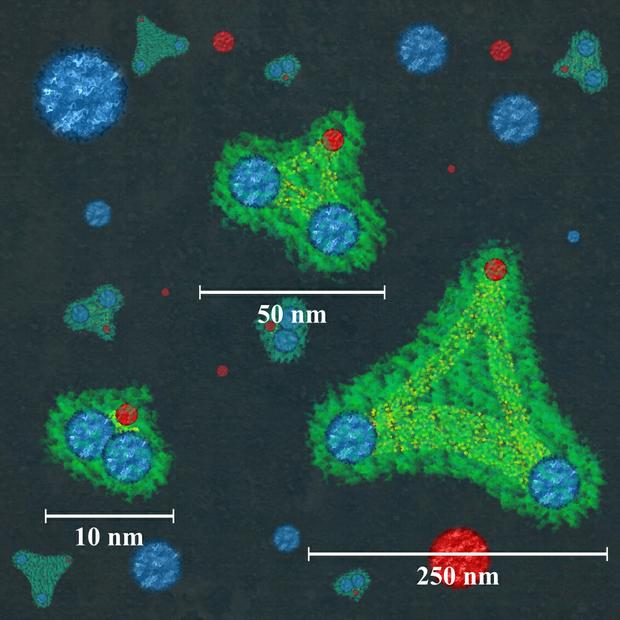When a two-body relation becomes a three-body relation, the behavior of the system changes. The basic physics of two interacting particles is well understood but the mathematical description of a three- or many-body system becomes so difficult that calculating the dynamics can blast the capacities of even modern super computers.
Under certain conditions, the quantum mechanical three-body problem may have a universal scaling solution and physicists from Heidelberg University say they have experimentally confirmed such a model. The scientists under Prof. Dr. Matthias Weidemüller investigated three-particle molecules, known as trimers, under exotic conditions.
The work is based on a theory posed by Russian physicist Vitaly Efimov more than 40 years ago. It focuses on finding physical laws capable of predicting the behaviour and energy states of an arbitrary number of particles. According to Efimov’s prediction, bound states of three atoms can be universally described under certain conditions.

Schematic representation of Efimov trimers formed from two cesium atoms and one lithium atom. While the trimer’s proportions are microscopic in its ground state, in the second excited state it is nearly a micrometer in size. The size of trimers scales based on a universal scaling law. These trimer states were observed in a mixture of cesium and lithium atoms at temperatures approaching absolute zero. Picture credits: Juris Ulmanis
The scientist found that infinitely many quantum mechanical bound states for the “ménage à trois” exist, even if two of the atoms cannot bind together. These so-called Efimov trimers are formed due to the long-range quantum mechanical interaction and they are completely independent of the underlying type of the three interacting particles.
Prof. Weidemüller says that Efimov’s prediction was considered “exotic” for a long time, since the conditions under which these molecular three-body bound states exist seemed unattainable in research. “Physicists with different scientific backgrounds have tried in vain to find signatures of the Efimov trimers,” explains the Heidelberg scientist.
It was only about ten years ago that scientists from Innsbruck were able to provide clear evidence for these trimers in systems consisting of three identical atoms. Shortly afterwards, physicists working with Prof. Dr. Selim Jochim in Heidelberg succeeded in measuring the exact binding energy of the Efimov trimers.
In the course of scientific work performed at the Center for Quantum Dynamics and the Institute for Physics of Heidelberg University, further properties of the exotic Efimov trimers were investigated. To this end, the researchers cooled a gas of two different atomic species – caesium and lithium – to temperatures close to absolute zero. At the same time, they took care to precisely control the interaction between these lithium and caesium atom pairs.
In an ultra-high vacuum chamber the atoms were cooled solely by laser light and stored by light forces in a focused laser beam for several seconds. The coupling strength between the atoms can then be controlled by changing the magnetic field. For this Prof. Weidemüller’s team made use of what are known as atomic scattering resonances. The evidence of the trimers is based on the decay into their three components at a well-defined coupling strength.
The strength of this coupling scales independently of the respective trimer bound state according to a purely numeric scaling factor. “We proved that the universal scaling is also valid in systems with different atoms,” says Rico Pires, who is working on his dissertation in Weidemüller’s team.
These scientists also succeeded in confirming that the scaling factor changes for a trimer of different particles as opposed to a trimer state of identical atoms, as PhD student Juris Ulmanis explains. They thus showed that Efimov’s theory is applicable to a large number of systems. Project leader Dr. Eva Kuhnle points to another success of the experimental work: “For the first time we were able to not only prove the existence of the trimer ground state, but also the first two excited states. These molecules consisting of three atoms then reach macroscopic sizes, comparable to that of a bacterium.”
Weidemüller emphasizes that these research results are important for many areas of physics – ranging from atomic to nuclear physics: “It is not only the evidence for the universal scaling behavior that is interesting, but also the accurate measurement of the tiniest deviations of this scaling. From this we gain new knowledge how Efimov’s theory can be applied to realistic three-body systems. Our aim is a deeper understanding of quantum mechanical many-body systems, one of the most important but also most difficult research areas in modern physics.”
Citation: R. Pires, J. Ulmanis, S. Häfner, M. Repp, A. Arias, E. D. Kuhnle and M. Weidemüller: Observation of Efimov Resonances in a Mixture with Extreme Mass Imbalance. Phys. Rev. Lett. 112, 250404 (published 25 June 2014), doi: 10.1103/PhysRevLett.112.250404






Comments